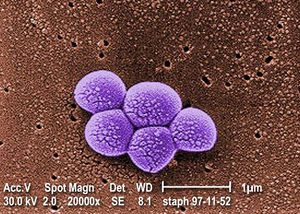Pseudomonas aeurignosa
Introduction to
Pseudomonas aeruginosa

By [Alexis Newman]
Pseudomonas aeruginosa is a powerful pathogen responsible for a multitude of different infections including respiratory and blood infections, especially for individuals who are hospitalized for long periods or have underlying medical conditions. This bacteria is common in Urinary Tract infections, Pneumonia, and Cystic Fibrosis. This bacteria is also the number one nosocomial (hospital-acquired) infection worldwide.
P. aeruginosa is so strong due to its antibiotic-resistant abilities. It's gram-negative encasement provides a structure that has evolved to fight off any medication
Double brackets: [[
Filename: PHIL_1181_lores.jpg
Thumbnail status: |thumb|
Pixel size: |300px|
Placement on page: |right|
Legend/credit: Magnified 20,000X, this colorized scanning electron micrograph (SEM) depicts a grouping of methicillin resistant Staphylococcus aureus (MRSA) bacteria. Photo credit: CDC. Every image requires a link to the source.
Closed double brackets: ]]
Other examples:
Bold
Italic
Subscript: H2O
Superscript: Fe3+
Sample citations: [1]
[2]
A citation code consists of a hyperlinked reference within "ref" begin and end codes.
To repeat the citation for other statements, the reference needs to have a names: "<ref name=aa>"
The repeated citation works like this, with a forward slash.[1]
Section 1
Include some current research, with at least one figure showing data.
Every point of information REQUIRES CITATION using the citation tool shown above.
Section 2
Include some current research, with at least one figure showing data.
Section 3
Include some current research, with at least one figure showing data.
Section 4
Conclusion
References
Authored for BIOL 238 Microbiology, taught by Joan Slonczewski,at Kenyon College,2024
